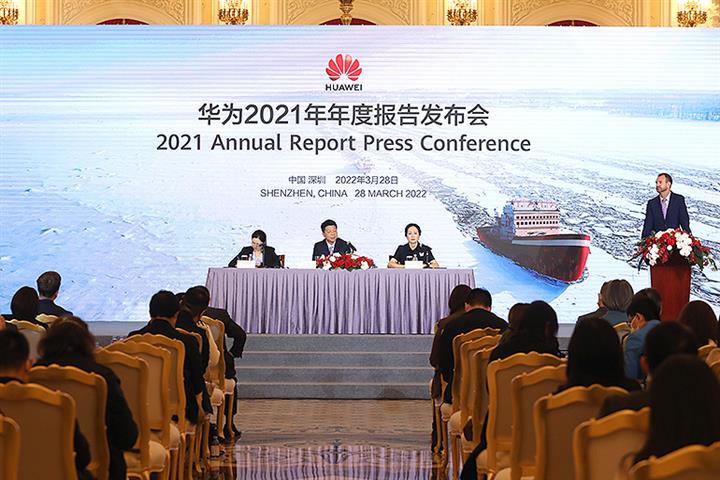 Huawei Logs First Annual Revenue Drop as Asset Sales, Better Efficiency Boost Profit
Huawei Logs First Annual Revenue Drop as Asset Sales, Better Efficiency Boost Profit(Yicai Global) March 29 -- Huawei Technologies had its first-ever decline in annual revenue last year, but profit at the Chinese telecoms giant surged because of asset disposals and improved operating efficiency.
Revenue slumped 29 percent to CNY636.8 billion (USD99.9 billion) in the year ended Dec. 31, the Shenzhen-based company’s 2021 earnings report showed yesterday. Net profit soared 76 percent to CNY113.7 billion.
A halving of income at Huawei’s consumer business hit revenue after the sale of its Honor budget handset brand in late 2020 as a result of restrictions on Huawei buying US-made technologies such as chips. The profit gain came mainly from selling assets such as Honor and xFusion Digital Technologies, an information technology services provider, as well as better operational efficiency, and an optimized product mix, Huawei said.
“Despite a revenue decline in 2021, our ability to make a profit and generate cash flows is increasing, and we are more capable of dealing with uncertainty,” Chief Financial Officer Meng Wanzhou, eldest daughter of Huawei founder Ren Zhengfei, said in a statement.
The US government added Huawei to its so-called Entity List in May 2019 over alleged national security concerns, hampering the Chinese company’s access to US software and hardware. The ban had a huge impact on its smartphone business, once the firm’s main revenue stream, forcing it to sell assets and diversify into other areas.
Huawei made CNY57.4 billion from asset disposals last year, versus CNY592 million (USD92.9 million) in 2020, while income from its consumer business halved to CNY242.4 billion, the report showed. Cash flow jumped 69 percent to CNY59.7 billion (USD9.4 billion) in the year.
“Over the past three years, an extremely challenging business environment -- not to mention substantial non-market factors -- have complicated our business operation,” rotating Chairman Guo Ping said.
“While many have been watching to see whether Huawei might fall, we have maintained focus on creating value for customers and working together with our ecosystem partners to foster shared success,” he said.
Profit Boosters
The higher profit resulted from changes to the product mix, an enhanced management supply chain, and the continuous accumulation of information and communication technologies that lifted operational efficiency, Meng said at a press conference.
Meng returned to China last September from Canada, where she had been under house arrest for almost three years over allegations of bank fraud after companies linked with Huawei allegedly tried to sell equipment to Iran in violation of US sanctions.
Huawei’s spent 0.5 percent more on research and development expenditures last year, bringing the figure to CNY142.7 billion, the equivalent of over 22 percent of total revenue, up from 16 percent in 2020, it said. Huawei has invested more than CNY845 billion in R&D over the last decade.
Revenue from its carrier business fell 7 percent to CNY281.5 billion. To date, Huawei has signed over 3,000 commercial contracts for industrial fifth-generation applications worldwide to assist global operators in deploying the 5G network, it noted.
Over 700 cities and 267 Fortune 500 companies had chosen Huawei as a partner for their digital transformation as of last December.
Huawei realized growth in fields such as wearable devices, smart screens, true wireless stereo headsets, and consumer cloud. By the end of last year, the company’s self-developed operating system, HarmonyOS, had been installed on 220 million devices.
Editors: Dou Shicong, Futura Costaglione